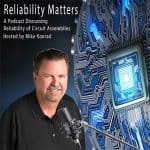
Component Tape Splicing Best Practices with Larry (The Professor) Welk
Optimization has become an important goal within the electronic assembly industry. While modern electronic assembly techniques utilize a variety of equipment, one specific type of equipment often consumes a disproportionate percentage of the overall equipment budget, that is the place machine. The cost of the machine, associated conveyors and feeders, require that the machine is running as often as possible.
The airline Industry refers to this as “wheels up” time. Airlines make money when the aircraft is in the air “wheels up”. On the other hand, anytime the wheels are down, the aircraft is not making money for the airline.
I listened to an interview a few years ago with the CEO of Southwest Airlines, a US discount carrier. Unlike most other airlines, Southwest does not charge its customers to check bags. The CEO was asked by the reporter why they have not joined the rest of the industry in charging for checked bags. The CEOs answer was genius. If Southwest Airlines began charging for check bags, it would actually slow down the boarding process as more and more passengers would drag their bags onto the aircraft most likely resulting in a number of those bags having to be checked at the gate.
Southwest Airlines is famous for having the fastest aircraft gate turns in the industry, frequently under 30 minutes. Yes Southwest airlines charged for checked baggage, it would require more time at the gate before the next flight would be ready to depart. That would result in fewer flight segments per aircraft per day. In other words, allowing customers to check bags for free equates to more “wheels up” time and, subsequently, more profit for the airline.
The same principal can apply to pick and place machines. When Pick and machines are running product, they are making presumably making money. When they sit idle, they are arguably costing money. What can assemblers do to improve the optimization or “wheels up” time on their pick and place machines?
My guest today, Larry Welk believes he has an answer. Larry Welk, a.k.a. Professor spice is the co-owner of Smart Splice, a manufacturer of tape splicing tools.
Larry will review tape splicing best practices and explain how tape splicing, when performed correctly, can lead to higher pick and place machine optimization.
So, buckle your seatbelt this podcast episode is officially wheels up!
Larry’s Contact Information:
Larry Welk
lwelk@smartsplice.com
 Ask a question or send along a comment.
Please login to view and use the contact form.
Ask a question or send along a comment.
Please login to view and use the contact form.
Leave a Reply